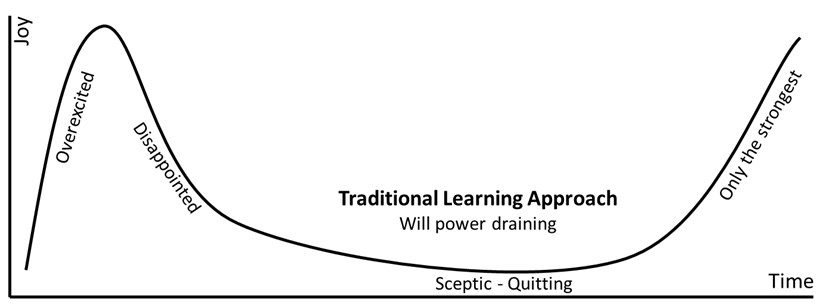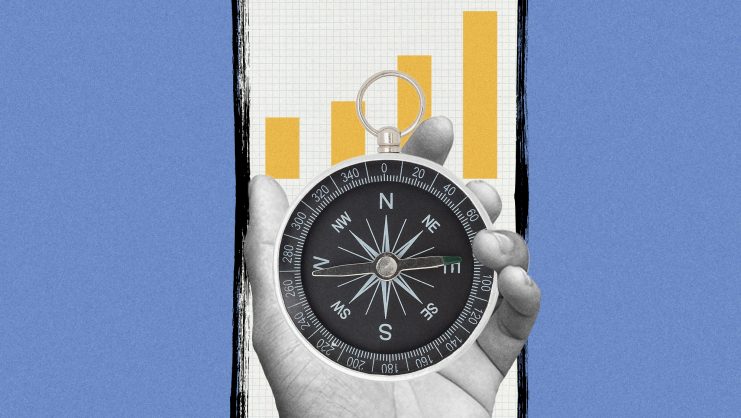Today’s workers, from entry-level employees to managers and entrepreneurs, may not clock more hours than their early 20th-century peers (in fact, in many countries, people are working fewer hours than in the past), but they certainly juggle a broader range of roles and responsibilities. This is where technology comes into play, having developed exponentially since the massification of the internet and now we are at the dawn of artificial intelligence. Across industries and within all levels of organizations around the world, people count on tools to execute tasks in minutes that previously would have taken days.
However, this type of working environment – fast paced, innovative, collaborative – requires the constant acquisition of new skills. This, ironically, adds even more complexity, and increases the odds for fatigue, resistance to change, and burnout – because learning demands additional personal resources, it requires our attention, our time, and our energy. Yet, in an ever-evolving workplace, continuous learning is essential. So, how can we acquire new skills and knowledge while also preserving our cognitive energy and willpower?

When pursuing personal and professional growth, we often turn to formal training programs, books, and seminars because we expect these well-worn paths will lead us predictably to new skills and insights. They often and consistently do. However, some of the most profound learning experiences can come from unexpected sources – even our most typical, everyday exchanges.
For example, I recently connected with an ex-colleague of mine, “Jane,” who is a seasoned professional in corporate communications. She told me that she found a surprising source of personal and professional development not in a specialized training session or the boardroom but at the desk right next to hers. Jane’s small, seemingly commonplace interactions with “Mike,” a well-organized executive assistant twenty years her junior whose work was unrelated to her own, turned out to be instrumental in shaping her career trajectory and even her personal life.
Jane and Mike got along pretty well. They’d go for coffee breaks together and engage in small talk while they worked separately, side by side. Jane recalled to me a conversation with her manager at the time who had noticed that she’d become more effective and efficient at work and was building better relationships with her peers. Later on, this proved to be a key reason why she was chosen to lead one of the company’s most important projects. Jane was the first to acknowledge that these improvements were in direct relation to her interactions with Mike. But when I asked her exactly how she had learned these new skills from Mike – I was expecting her to tell me a series of activities and was ready to take notes – her reply took me by surprise. I don’t know, she admitted.
Since then, I have had dozens of conversations with people about their career paths. The recurring theme is that those people who are able to gain new skills and use them to truly improve their capabilities – especially those soft skills – are individuals who are “inspirable.”
Inspirable people are particularly permeable to the positive behaviors of others. They easily – almost unconsciously – bond and connect with the people in or simply near their personal network, spending time with neighbors, colleagues, and acquaintances. Just watching people around them face challenges and achieve goals makes them jump off the couch and get into action.
Sometimes I talk to leaders about the need to be inspirable, and they reply to me: Yes, I agree with you, we must be inspirational! I don’t blame them. For centuries, we have thought that among the most important elements for an endeavor to succeed was to have an inspirational leader (at one point not so long ago, one of the essential traits was “charismatic”) setting a clear and motivating direction for the team. What must now be newly considered is that in order for inspiration to flow, everybody, including the leaders, need the capacity to be inspired, to be able to learn and gain energy from those around them.
As mentioned, this is almost an unconscious process. Yet, we can make efforts to replicate it, for example by purposely spending time with those skilled people with whom we are already in contact with – whether they are officemates, department colleagues, classmates, a friend of a friend, the list goes on. The key is to not actively pull specific learnings out of these relationships but to be permeable to what these relationships eventually offer you.
Behavioral sciences clearly explain how this works. For example, Gustave Le Bon’s seminal work from 1895, The Crowd: A Study of the Popular Mind, delves into how individual thinking and behavior can be heavily influenced by group dynamics. Complementing this, contemporary psychologist Robert Cialdini explores, nearly a century later in his book Influence: The Psychology of Persuasion, the concept of social proof, which he defines as the phenomenon where individuals copy the actions of others in order to reflect what is considered correct behavior for a given situation. The value of understanding these principles like that of Le Bon and Cialdini lies in the potential to harness and guide these naturally occurring patterns of behavior intentionally in both home and work environments, turning what is typically an unconscious influence into a tool for positive change.
The workplace has indeed gone through some dramatic shifts as of late. We have moved from office to home, then back from home to office, or into hybrid mode. The workforce has been shaken up and around the world, there is worker detachment and a widening gap between employees and management. What started as the dawn of a new work-life balance era turned into an era of mistrust and isolation.
What if we could help individuals in organizations become more open to inspiration? My conversations with numerous business leaders have led to the understanding that people who are open and willing to engage frequently with others are more adaptable to change and likely to evolve. Thus, organizations should provide an environment where individuals can thrive in this way. I suggest the following attributes:
Openness. In order to grow by being inspired by others, people need an open mind and heart for both sharing and receiving. In the workplace, this shows itself as employees reaching out to colleagues for advice, support, feedback, and new ideas. There is a willingness to share knowledge and to ask questions in a transparent way. Leaders can foster these behaviors in two ways; first, by being a role model in asking the team for advice in public and, second, by creating spaces exclusively for this purpose.
Safeness. Employees are comfortable with crossing the hidden boundaries within traditionally structured organizations. This means that workers easily make connections and build strong bonds with one another, regardless of pay grade, gender, political views, race, sexual orientation, physical ability, ethnicity, or age. Leaders along with their teams should redefine the rules of their periodic meetings so that everyone feels secure and participation is encouraged. Also, it is good practice to periodically survey employees about their impressions of how safe the workplace environment is.
Well-being. In order to be able to be inspired by another person, one needs to first and foremost feel well and thus the physical and mental health of everyone in the organization is of utmost importance. This often comes from an environment of reduced stress. While this might not always be possible within an organization, leaders can and should strive to create a balanced working environment for employees, for example by checking at the beginning or end of each meeting how are the participant’s doing and encourage them to share if they are not doing well. A higher level of well-being across the company comes with many benefits, including higher employee and client retention, and a wider and deeper impact on society.
Creating an inspirable workforce starts at the top. When company leaders demonstrate a willingness to connect across hierarchical boundaries and show an openness to being inspired by others, including their own junior employees. Leaders are also in charge of removing all the obstacles that prevent people from connecting and inspiring each other, it profoundly influences the organizational culture.
This approach should be more than encouraged; it must be embedded into the fabric of company practices. Such leadership not only fosters resilience, adaptability, and innovation but also enriches the professional and personal lives of all team members.
Being inspirable is not a passive state but a dynamic engagement. Start your day by asking yourself: who are those people who are very good at what I want to improve? Leaders and employees alike should actively transform everyday interactions into opportunities for meaningful development and impactful leadership, fostering a positive and productive work environment for everyone. This active pursuit of inspiration creates a workplace where continuous growth and mutual enrichment are part of the daily experience, driving the organization toward sustained success.
© IE Insights.











